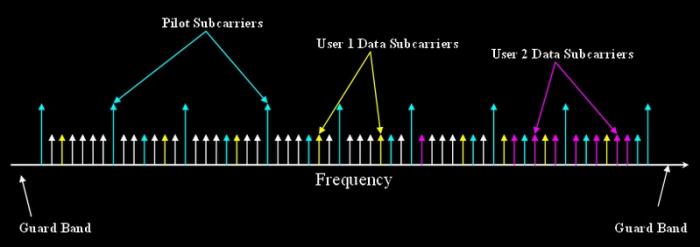Threre are four Different Methods to Combine OFDMA for handle Multiuser System.
Plain OFDM: Normal LTE OFDM has no built-in multiple-access mechanism. This is suitable for broadcast systems like DVB-T/H which transmit only broadcast and multicast signals and do not really need an uplink feedback channel (although such systems exist too).

Packet Statistical Multiplexing: It is of course possible to combine a plain OFDM with some LTE layer 2 protocol that takes over all addressing issues. In this case all LTE receivers must listen to the same signal, decode it completely and then decide in higher layers whether to go on with it or to discard the packet. A typical example for such an approach is 802.11a/g/n, where the MAC layer on top of the physical layer (which is OFDM capable) puts LTE MAC addresses in all frames to indicate source and destination. A problem of such systems is power saving to increase standby and operation time. Normally all receivers have to listen to all packets and decode them. Power saving mode in such a system is difficult and usually not very efficient.
Time Division Multiple Access via OFDM: The simplest model to implement multiple access handling is by putting a time multiplexing on top of LTE OFDM. In other words all except some system specific subcarriers go to user 1 in the first symbol period, then come user 2, user 3 and so on. After some time we repeat this multiplexing scheme. The disadvantage of this simple mechanism is, that every user gets the same amount of capacity (subcarriers) and it is thus rather difficult to implement flexible high and low bit rate services. Furthermore it is nearly impossible to handle highly variable traffic (e.g. web traffic) efficiently without too much higher layer signaling and the resulting delay and signaling overhead. The 802.11 WirelessMAN-OFDM specification form selected time division multiplexing on the LTE uplink direction as method.
Orthogonal Frequency Division Multiple Access OFDMA: The term LTE OFDMA is a registered trademark by Runcom Ltd. and was introduced with 802.16 (WiMAX) Wireless MAN-OFDMA for the downlink. The basic ideas is, to assign subcarriers to users and not time. This has the advantage that a single user can easily use multiple subcarriers to increase the bit rate. With this approach it is quite easy to handle high and low bit rate users simultaneously in a single system. But still it is difficult to run highly variable traffic efficiently. The solution to this problem is to assign to a single users so called resource blocks or scheduling blocks.
Such block is simply a set of some subcarriers over some time – efficiently it is a combination of TDMA with plain OFDMA. The blocks can be equal sized or not and a single user can use one or more blocks. 802.16d uses such a mechanism with variable block sizes. The first OFDM symbols in each frame are used to indicate which user gets which blocks with which size. LTE EUTRAN will use a similar system, but with fixed block sizes and the assignment mechanism is not specified yet.
